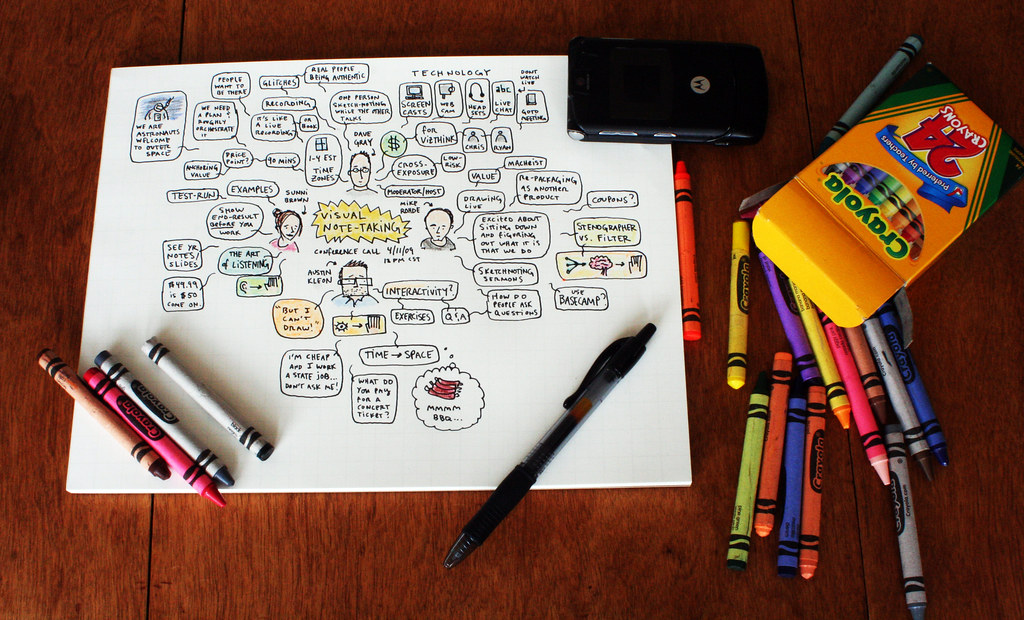Note-Taking #likeaboss
November 11, 2017
EasyUni Staff

(Source: https://www.flickr.com/photos/deathtogutenberg/3432300215/ )
Note-taking makes life a lot easier to handle when it comes time to take big tests and write assignments. It helps you recall information that you can easily forget weeks later. There are few techniques that seems to work best for most people in order to create, in effect, minutes for notes taking. You’ll definitely need to get prepared - have enough paper, pens, highlighters, sticky notes and it’s always useful to have a small notebook to quickly jot down your thoughts. Here are some great tips we feel will help you become a note-taking Ninja!
Keep it short!
One thing you must know is that your notes don’t have to contain everything that was discussed, mentioned or written; it should only have the most important things. No point wasting time writing things that you already know or facts you can find in your textbook. Use abbreviations to accelerate your speed and efficiency so that you don’t miss out on critical pointers. Just remember to remember what your abbreviations mean though!
Have empty spaces
This is a simple but handy little tip that has helped me immensely to insert any special notes or bullet points that may come up later during the discussion. The extra space helps you see all your notes in one place so you don’t “miss a point”, plus it makes reading back on your notes much easier and clearer.
Be more visual, colourful!
There really is truth attached to the saying that “a picture is worth a thousand words.” Diagrams and pictures are a great tool to help you visualize what you hear or read and possibly allow you to see how different ideas connect. A dose of colour will make your notes more attractive, so use some highlighters and coloured pens or try colourful type on your computer. Also try out some nice fonts on your laptop, whatever works! The pictures you drew and the words that been highlighted with different colours will help you understand the material better!
Keep it in order, one place!
Most important point is, don’t keep your notes on oddly shaped pieces of paper or stored in many places and tools on your laptop. It’ll only make it harder for you to reopen it again when it needed. Stay organized so that you don’t get confused later when you read your notes again. Keep notes in order, and in one folder. It’s for your own good, believe it or not.
Why paper? Save the environment, be tech savvy!

(Source: http://www.rifeshare.com)
Well well...what if you’re not a notebook kind of person? Embrace technology by making the most out of your laptop/ phone/ tablet with some great tools they provide out there, such as: Google Drive, Microsoft OneNote, Evernote, and many more. Those tools provide most of the advance options for you to create and read notes in more fun way ; capturing information through typing, snapping photos and screenshots, recording audio, cutting and pasting, sometimes saving entire webpages. Bonus for you, you can always check out your notes on the go, anytime, anywhere once it is stored on the ‘cloud’.
Go retro with some method of taking notes. Why not?

(Source: )
There are several methods that might work. Once you understand, choose the method that works best for you, then you can figure out which note taking system helps you to recall the information later. Here are the methods and the way it works. Check these out!
The Cornell Method

(Source: www.learnhow2study.com)
Draw two columns in your notebooks which divide different sections; the left and the right side. The left column will become your self-test column or review. The right, larger column is the note taking area where you will write your lecture notes. You can use paragraph format etc, include any informations needed such as diagrams, pictures, graphs, and other relevant or special explanation expresses during the lecture. As you go, pull out the main ideas and write key words to summarize main points of the lecturer in the left side, review/self test column. Develop and write the potential test questions that you think professor could ask on a test and see if you can answer them. After reviewing and revising your notes, write a short summary at the bottom page. Creating summary helps you to identify and understand and create a critical thinking about what you have learned.
The Mapping Method

(Source: )
Mapping is a graphic representation of the content of a lecture. It evolves in a note taking form which related each fact or idea to every other fact or idea. So this how it works; create lines by lines among ideas, point per point you want to emphasize so it helps you to understand the connections. This method maximizes active participation and emphasizes your critical thinking.
The Sentence Method

(Source: )
This is actually a good method when you find there’s lots of information and you don’t know how the ideas fit together. As it’s hard to determine major/minor points, you might also meet the difficulties while you edit and review with clean-up. This how it works; write every new thought, fact, or topic on a separate line as you progress, try to numbering each sentence. This method is actually organized than writing paragraphs and still records most of the information.
The Outlining Method

(Source: www.understood.org)
In history class you might write the name of an important leader, under it the key events that they are involved in. Under each of them you write a short description -Well that’s how this method works. Outlining is an effective way to capture the relationships between ideas and data.
The Charting Method

(Source: http://www.utc.edu/)
It’s obvious right? Create the chart! Set up your paper by drawing columns and give appropriate headings in a table. After you determine the categories to be covered, record all informations such as words, phrases, main ideas, etc into the chosen categories. All you have to do is set up your page in advance by table with different columns headed by those categories. Easy, isn’t it?
Like the wise men say, sharing is caring; exchange notes with your classmates. Consider this as a positive result of peer pressure. If you think of it again, it actually gives you motivation too: you’re more likely to do your notes better in the first place because you know you’ll be sharing with your peers.
So good luck!
Do you have a different note taking style? Share us some tips! Join us in our forum section now!
You might be interested in...
- Sunway University launches New Medical School to transform Healthcare Education
- What to Do After IGCSE/O-Level? Best Study Pathways in Malaysia
- Xiamen University Malaysia Scholarships for International Students in 2025
- Why AI in Education Matters?
- EdUHK Wins Grand Prize at iCAN 2024 Achieves the Best Performance among Hong Kong Universities
- Sunway University Ranked Malaysia's No. 1 Private University in 2025
- A Sunway University Student's Journey from Cerebral Palsy to Graduation
- APU Dominates the 2024 Private Education Excellence Awards with Dual Wins
- The Young & the Wired: How Youth are Redefining the Digital Era?
- Promoting Inclusivity at Malaysian Universities: Tips for Malaysian and International Students
 +60142521561
+60142521561





